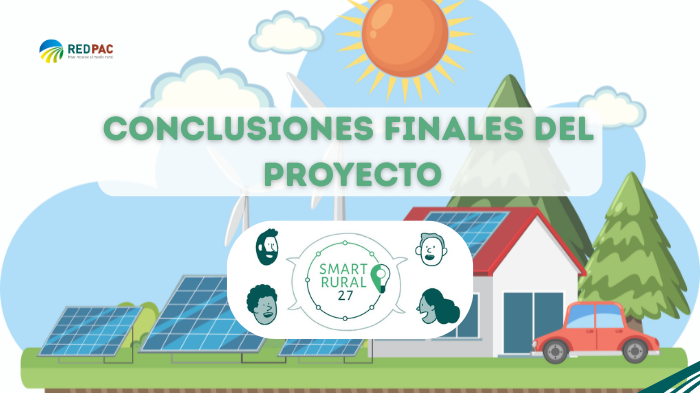
07 de May de 2025
Dinamización rural
Innovación
Resiliencia y competitividad
The final report of the “Smart Rural 27” project identifies the LEADER approach as the main tool for implementing smart villages in some Member States.
- The final report of the “Smart Rural 27” project identifies the LEADER approach as the main tool for implementing smart villages in some Member States.
- The project was created to implement new CAP policies in Member States to facilitate the emergence of "smart villages" throughout the European Union.
The European project “Smart Rural 27” It was born in 2020, as a continuation of the "Smart Rural 21" project , with the aim of implementing the Common Agricultural Policy (CAP) after 2020, as well as other European Union (EU) policies and initiatives, which would favor the emergence of "smart villages" throughout the European Union. The birth of this project was already reported at the time by the defunct National Rural Network to encourage rural areas in Spain to apply for this initiative .
The characteristics that a “smart town or smart village” should have responded to:
- Have enthusiastic leaders who are committed to developing and implementing a smart town strategy.
- Have the human capacity necessary to mobilize for and in the process of smart town.
- Count on support, ideas and inspiration.
- Have certain basic technical capabilities:
- Sufficient broadband connectivity.
- Some initial ideas, flagship projects , or planning activities carried out on which the smart town process can be built, although this was not a prerequisite either.
- Candidates were expected to be open to knowledge sharing and cooperation with other peoples and stakeholders.
Ultimately, “smart villages” were established as rural communities that implemented measures to retain and attract people to live and work in their communities.
Finally, in Spain, Ansó was the only Spanish town selected by Smart Rural 21 to become a “smart village.”
Project conclusions
The final conference of the Smart Rural 27 project (Brussels, 19-19 March 2024) brought together around 150 people from local rural communities, Local Action Groups ( LAGs ) and the LEADER approach , representatives of regions, CAP managing authorities, national CAP networks, European stakeholder organisations, representatives of European projects (such as Horizon 2020 and Horizon Europe ) and representatives of the European Commission.
The final report of the Smart Rural 27 project, published at the end of January 2025, summarizes the project's main findings, which clearly underscore the importance of the LEADER approach as a key tool for implementing smart villages. The project's recommendations thus focus on four main areas:
- Capacity building and awareness raising:
The report highlights the need for ongoing direct support to rural communities to develop smart village strategies and implement smart projects. Practical peer-to-peer exchanges, especially field visits , are particularly valued by stakeholders: knowledge exchange is key to the development of smart villages. Therefore, LAGs should have specific communication channels on smart villages.
- Improvements to the policy framework:
According to the report, close monitoring of the implementation of CAP interventions within the Smart Villages framework is necessary. Furthermore, knowledge sharing is necessary to facilitate peer learning, as more guidance is needed in Member States in parallel with the design of calls. It would be particularly useful to share the experience of countries where specific interventions are included in CAP Strategic Plans (CSPs).
- Promoting multi-funding approaches:
The project concluded that, in general, no additional funding is provided for the implementation of smart villages in LAGs that include them in their Local Development Strategies (LDS), although this option could still be considered by Member States themselves. Therefore, the report indicates that, in the future CAP Regulation, the European Commission should consider the possibility of LAGs specifically supporting local municipalities in becoming smart villages.
This "smart villages" project is currently only programmed through the CAP Regulation. Policy analysis conducted by Smart Rural 27 showed that no other specific interventions within other EU programs appear to directly support smart villages.
- Continuity of the Smart Towns Observatory:
The project created the European Smart Villages Pilot Observatory , which consists of 3 legs :
- Smart Rural Community Knowledge Clusters : to support the exchange of practices and capacity building among rural communities interested in and active in the same thematic areas as smart villages, such as renewable energy communities, digital services, rural enterprises, mobility and transport, etc.
- The national/regionalSmart Villages Working Groups aim to improve policy implementation —particularly interventions under the CAP Strategic Plan, but also other relevant Smart Village policies, programs, and measures—by generating practical exchanges between various stakeholders (communities, LAGs, local authorities, networks, associations, etc.) in a given national/regional context. The working groups are therefore country-specific and are implemented in the national language.
- European stakeholder platforms (Smart Villages) seek to generate exchanges on the implementation of Smart Villages among stakeholders with similar responsibilities in Member States, with the aim of mutual learning, improving the support framework for Smart Villages, and drawing lessons at the European level. Consequently, stakeholder platforms are international and focus on specific stakeholder groups, such as the LEADER LAG/Agent platform, the CAP Managing Authorities platform, etc.
Generated tools
Particularly useful tools produced by Smart Rural 27 include a geographic mapping tool and an analysis of support for Smart Villages in the 2023-2027 Climate Action Plans, including detailed factsheets for each Member State and a synthesis report .









